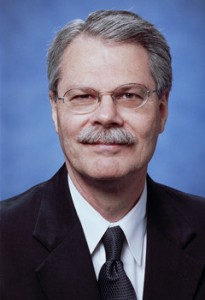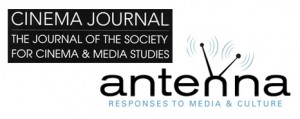Report from: Generation(s) of Television Studies
 The Generation(s) of Television Studies symposium, held at the University of Georgia last Friday, made visible just how influential Horace Newcomb has been to the field. Over the course of the afternoon presentations, his TV: The Most Popular Art was invoked as a “heretical text” in the context of a film studies program, as an important intervention, and as the ur-text of American television studies. His students and colleagues spoke of Newcomb’s generosity and humility, even as his influence over the field was apparent in every speaker and every presentation. As Tom Schatz pointed out, though Newcomb may be embarrassed to be called a “father of television studies,” his former students now have their own generation of advisees to whom Horace Newcomb is an academic grandfather.
The Generation(s) of Television Studies symposium, held at the University of Georgia last Friday, made visible just how influential Horace Newcomb has been to the field. Over the course of the afternoon presentations, his TV: The Most Popular Art was invoked as a “heretical text” in the context of a film studies program, as an important intervention, and as the ur-text of American television studies. His students and colleagues spoke of Newcomb’s generosity and humility, even as his influence over the field was apparent in every speaker and every presentation. As Tom Schatz pointed out, though Newcomb may be embarrassed to be called a “father of television studies,” his former students now have their own generation of advisees to whom Horace Newcomb is an academic grandfather.
The generations of television studies scholars formed the structure of the day’s events: the morning was devoted to small-group and two-on-one workshopping of a few select graduate student papers with the visiting scholars. The afternoon session of scholarly presentations was devoted to the generation of television studies, a genealogy of the field with Horace Newcomb at the center. Organized by Jay Hamilton and UGA graduate students Evan L. Kropp, Mark Lashley, and Brian Creech, the symposium marked Newcomb’s retirement as both a full-time faculty member and as director of the Peabody Awards. The presenters reflected the celebration of the man and scholar: colleagues David Thorburn and Tom Schatz, and former students Amanda Lotz, James Hay, Alisa Perren, and Jeff Jones.
Both former students, Lotz and Jones focused on the integration of Newcomb’s contributions to the field into a common sense of television. Lotz began the afternoon session by discussing Newcomb’s article “Magnum: The Champagne of TV?” as a useful map to the field of television studies. She cited the article as the first use of the term “cumulative narrative” to describe the metaplot that extends over the full series but is separate from seriality, and used that metaphor to articulate the cumulative narrative of television studies from “Magnum: The Champagne of TV?” Within that article she could see the metaplot of the field, including: the politics of pleasure, the negotiation of narrative technique in a production economy, the provision of an alternative to rigid ideological analysis, and the way in which various aspects of television to be studied exist in conversation with each other. Where Lotz reflected on the ways the Magnum article had constructed a way of studying television that has become generally normalized for her, Jeff Jones expanded that normalization of Newcomb’s ideas to a general ontology of television with his focus on the concept of the cultural forum. Although the idea of television as a cultural forum has become so commonsense that it can sometimes seem irrelevant, Jones argued that it is still central to the way that we understand television, citing the recent attributions of changing popular sentiment on LGBT rights to its televisual representations.
Schatz and Perren took up Newcomb and Alley’s The Producer’s Medium as a significant influence on how television studies negotiates questions of authorship. Schatz focused on the tension between the film-studies mode of auteurism and the importance of writers and producers in television, peppered with anecdotes of his own friendship and colleagueship with Newcomb as an example of how film studies and television studies converge more than is sometimes thought. Perren also articulated the significance of The Producer’s Medium while calling for contemporary scholars and discussions of showrunners to continue to learn from that text. She argued that The Producer’s Medium positions producers/showrunners as a baseline for understanding broad continuity and changes in television and how there are still many issues of cultural gatekeeping regarding the powerful position.
Hay and Thorburn turned to the future of television studies and how Newcomb’s contributions to the field have paved the way for many possible avenues of media studies. Hay focused on how the intellectual formulation of television studies might lead the way to media studies of formerly invisible media, like smart appliances. He laid a hypothetical path from TV: The Most Popular Art toward a “critical refrigerator studies.” Thorburn, however, sees a full stop to the television that Newcomb had studied. He said that the first great age of television is over, and the next great age will be profoundly different. Regardless of what the next age of television looks like, however, he positioned Newcomb as a great scholastic gardener, never trying to recreate himself but instead cultivating a forest of scholars who will be able to tackle this new era.
At the close of the session, Horace Newcomb spoke about his history with television, both as a scholar and a teacher. As one of those “grandchildren” of television studies, to see Newcomb speak so passionately about himself, the medium, his work, the field, and his position in it was inspirational and electrifying. “I write about television because it changed my life,” he said; “growing up in Mississippi in the 1940s and 1950s, television gave me a different world . . . television is practical politics.” He ended the day by articulating his educational theory by way of Walt Whitman’s “Song of Myself”:
I am the teacher of athletes,
He that by me spreads a wider breast than my own proves the width of my own,
He most honors my style who learns under it to destroy the teacher.
Between the morning workshops and the afternoon papers, the colleagues, scholars, mentors and mentees gathered in Athens, Georgia stood as proof of that width, honoring Horace Newcomb by spending the day engaging with the field he helped shape.
 This post is part of an ongoing partnership between the University of Wisconsin-Madison’s Antenna: Responses to Media & Culture and the Society for Cinema & Media Studies’ Cinema Journal.
This post is part of an ongoing partnership between the University of Wisconsin-Madison’s Antenna: Responses to Media & Culture and the Society for Cinema & Media Studies’ Cinema Journal.
—–


